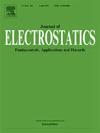Electrostatic separation of Al/Cu/PVC mixture using a cascade of flat horizontal discs
IF 2.1
4区 工程技术
Q3 ENGINEERING, ELECTRICAL & ELECTRONIC
引用次数: 0
Abstract
This paper presents a new configuration of an induction-type electrostatic separator aimed at metal/insulator recovery. The proposed setup features two flat, horizontal rotating discs, each connected to a different voltage amplitude. This design is intended to separate aluminum (Al) and copper (Cu) metals from a ternary mixture of aluminum, copper, and PVC (Al/Cu/PVC). The metallic particles moving under the two discs, placed in cascade, are attracted toward the first or the second disc depending on their weight. The first disc is intended to attract light aluminum particles, whereas the second disc with a higher voltage attracts copper particles. The required voltage for aluminum is approximately 5 kV, nearly the half of the required voltage for copper, which is 11 kV. Once the particles are attracted to the discs, they are radially ejected when they reach its surface. The collecting boxes, located on both sides of the discs, capture the separated materials. The separator is equipped with five boxes: two for aluminum, two for copper, and one for PVC, which remains on the conveyor and is recovered at the end. The separator is modeled and optimized using the design of experiments methodology. The main influencing factors were the voltages and the rotation speeds of the two discs. With optimal parameter values—UAl = 5.60 kV, UCu = 11.92 kV, and a speed of 149.7 rpm—the separator achieves a 100 % recovery rate and high purity: over 93 % for aluminum, 94 % for copper, and 100 % for PVC.
用水平圆盘级联静电分离铝/铜/聚氯乙烯混合物
介绍了一种用于金属/绝缘体回收的感应式静电分离器的新结构。所提出的设置具有两个平坦的水平旋转圆盘,每个圆盘连接到不同的电压振幅。该设计旨在将铝(Al)和铜(Cu)金属从铝、铜和PVC (Al/Cu/PVC)三元混合物中分离出来。在两个圆盘下运动的金属颗粒呈级联排列,根据它们的重量被第一个或第二个圆盘吸引。第一个圆盘旨在吸引轻铝颗粒,而第二个圆盘具有较高的电压吸引铜颗粒。铝所需电压约为5千伏,几乎是铜所需电压的一半,铜所需电压为11千伏。一旦粒子被吸到圆盘上,当它们到达圆盘表面时就会呈放射状喷射出去。位于圆盘两侧的收集盒捕获分离的材料。分离器配有5个盒子:两个装铝,两个装铜,一个装PVC,这些盒子留在输送机上,最后回收。采用实验设计方法对分离器进行了建模和优化。主要影响因素是电压和两个圆盘的转速。在最佳参数值(uu = 5.60 kV, UCu = 11.92 kV,转速为149.7 rpm)下,该分离器回收率为100%,纯度高:铝的回收率为93%以上,铜的回收率为94%,PVC的回收率为100%。
本文章由计算机程序翻译,如有差异,请以英文原文为准。
求助全文
约1分钟内获得全文
求助全文
来源期刊

Journal of Electrostatics
工程技术-工程:电子与电气
CiteScore
4.00
自引率
11.10%
发文量
81
审稿时长
49 days
期刊介绍:
The Journal of Electrostatics is the leading forum for publishing research findings that advance knowledge in the field of electrostatics. We invite submissions in the following areas:
Electrostatic charge separation processes.
Electrostatic manipulation of particles, droplets, and biological cells.
Electrostatically driven or controlled fluid flow.
Electrostatics in the gas phase.
 求助内容:
求助内容: 应助结果提醒方式:
应助结果提醒方式:


